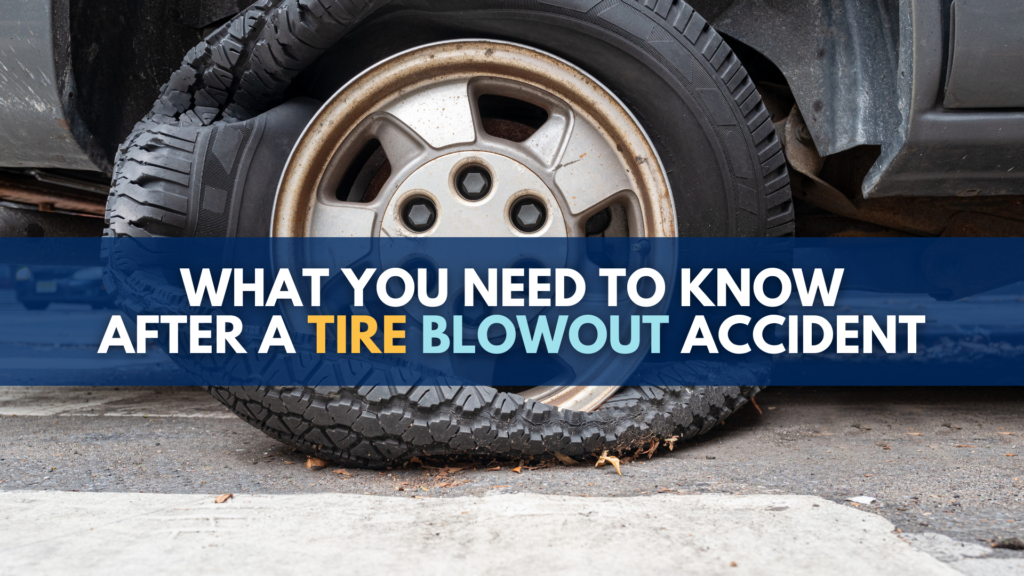A tire blowout accident is always dangerous and deadly. While poorly maintained trucks are the leading cause of deadly tire blowouts, passenger cars with under-inflated and worn tires are also major causes, as are tire defects, potholes, and overloaded vehicles. Most of these crashes are preventable.
What is a tire blowout accident?
A tire blowout accident occurs when there is a rapid loss of tire air pressure – or sudden deflation of the tire – that causes a driver to lose control of his or her vehicle. This can cause a driver to swerve off the road, drive into oncoming traffic and experience a rollover.
What are the causes for this type of crash?
Two major causes for these types or crashes are under-inflated tires and/or tires with worn down tire treads. Other causes can include a manufacturing defect in the tire or its tread, poorly maintained road conditions, such as potholes or debris in the roadway, and “overloading” of the vehicle that experiences a tire blowout.
Can you file a lawsuit if injured in this type of crash?
As most tire blowout accidents are preventable, you can sue if you have been injured or a loved one has been killed. Most of these incidents are caused by poorly maintained tires, especially accidents involving tires from large trucks and tractor trailers. You may also be able to sue an at-fault driver of a passenger car, an auto insurance company, a tire company or body shop, a road commission for poorly maintained road conditions and a tire manufacturer based on the underlying circumstances that caused the crash.
What can I sue for?
If you are injured from a tire blowout accident, you can sue for pain and suffering damages, economic loss and medical bills related to your injuries. If you live in Michigan or another No-Fault state, you can also sue for unpaid and overdue No-Fault benefits. If a loved one was killed, the estate can bring a wrongful death lawsuit. If the crash is caused by a tire defect, you can sue the manufacturer for negligent design in a product liability lawsuit.
Who can you sue?
You may be able to sue: (1) the at-fault driver of the car whose tire had a blowout for negligent inspection, maintenance and/or vehicle overload; (2) the auto insurance company that refused to pay your No-Fault benefits; (3) the mechanic/service shop who negligently installed or repaired the tire; (4) the tire manufacturer for faulty design/construction and failure to warn; and/or (5) the road commission who failed to keep the roadway in safe repair assuming the road commission or municipality had notice and the condition existed for some length of time.
If a truck is involved, the trucking company can be sued for negligent maintenance and the truck driver may also face liability if the condition was visible and could have been caught on a pre-trip inspection.
Is a tire blowout an at fault accident?
Most of these crashes are preventable, and are caused because of poorly maintained tires that were not repaired or replaced. A crash that results in an injury or death can have multiple liable parties responsible for the blowout which resulted in the car or truck crash. At-fault parties could include a driver, a mechanic or service shop, the tire manufacturer and/or the road commission responsible for the roads. The trucking company that owns a truck is required under federal and state regulations to safety maintain tires.
Tire blowout accident statistics
There were 622 fatalities in “tire-related” motor vehicle crashes, which includes tire blowout accidents, nationwide in 2021, according to NHTSA. Nine percent of motor vehicle crashes nationwide have been “tire-related.” Tire failure causes approximately 11,000 crashes a year.
How do you prevent a tire blowout accident caused by under-inflated tires?
Maintaining proper tire pressure is the most important thing that drivers can do to keep their tires in a safe condition and, thus, prevent a crash. Drivers should check their tires’ pressure at least once a month to make sure they are at the recommended pressure in pounds-per-square-inch (PSI).
NHTSA also recommends:
- Purchasing a tire pressure gauge to keep in your vehicle because it is estimated that tires lose one PSI every month
- Take action when your Tire Pressure Monitoring System (TPMS) indicator illuminates because that means that at least one of your tires is more than 25% underinflated
How do you prevent these crashes caused by worn tires?
Drivers should regularly monitor the tread on all of their tires because when the tread is worn down to 2/32 of an inch or less the tires are no longer safe and should be replaced. Drivers should also check the recommendations of the vehicle and tire manufacturers as to the maximum service life for the tires.
NHTSA recommends:
- Watching for treadwear indicators such as raised sections spaced throughout the bottom of the tread grooves
- Trying the “penny test” which involves placing a penny in the tread of your tires with Lincoln’s head upside down and facing you – If you can see the top of Lincoln’s head, then your tire has less than 2/32 of an inches of tread and the tire should be replaced
- Check the week and year that your tire was manufactured by looking at the tire identification number (TIN) on the sidewall of the tire
Need help finding the right lawyer after a crash? Call Michigan Auto Law
If you have been injured in a tire blowout accident and would like to speak with an experienced attorney, call toll free anytime 24/7 at (248) 353-7575 for a free consultation with one of our injury lawyers. Our attorneys have successfully litigated these types of cases. Michigan Auto Law attorney Steven Gursten has appeared on television news shows offering expert commentary on the causes of these cases. Michigan Auto Law has also recovered the largest truck settlement of the year in Michigan in a case involving a serious injury from a tire blowout accident and several multi-million dollar settlements involving these types of cases. You can also get help from one of our experienced attorneys by visiting our contact page or you can use the chat feature on our website.
(Sources: NHTSA, https://www.nhtsa.gov/equipment/tires; NHTSA, “Tires: Your safety and your life are riding on them”; NHTSA, “Dangers of Tire Failure”)




